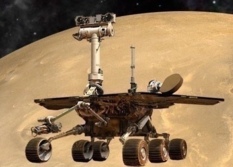A.J.S. Rayl • Mar 05, 2015
Mars Exploration Rovers Update: Opportunity Discovers New Rock Type, Updates Flight Software
Sols 3918 - 3945
Opportunity stayed the course along the western rim of Endeavour Crater toward Marathon Valley in February. While the pace may have seemed a little slow going, behind the scenes, it was anything but. From the discovery of a new rock type to a successful flight software upload that should enable the robot field geologist to regain her long-term, flash memory, the Mars Exploration Rover (MER) and her team delivered what turned out to be a hugely productive and memorable 133rd month on the Red Planet.
It has never stopped, really. There's so much more for Opportunity to see and do that the options and possibilities caused heated and impassioned debates at the annual MER team meeting held February 25th-26th at Caltech. From the enthusiasm that still emanates from and seems to surround this mission, you'd think the robot field geologist had just landed yesterday.
"We've still got a lot of stuff going on," said Steve Squyres, MER principal investigator, of Cornell University. But at the moment, it's what lies ahead that has everyone talking.
Opportunity is knocking on the door of Marathon Valley, slowly venturing into one, if not the most significant trips back in time on the Red Planet, a science site where discoveries are there for the making. During the first eight years or so of her ongoing expedition, the robot uncovered solid evidence for highly acidic past water, but the clay minerals lying in wait in the valley indicate the presence of an ancient wet environment where water was more neutral, more like water you and I would drink.
Clay minerals were detected around Endeavour's western rim from orbit back in 2009 and the mission got its first real glimpse of them at Matijevic Hill in Cape York, about a year after arriving at the big crater in August 2011. "But Marathon Valley holds the mother lode," said Ray Arvidson, MER deputy principal investigator, of Washington University St. Louis. It’s a mother lode the MER scientists have been thinking about since that orbital discovery was made with the Compact Reconnaissance Imaging Spectrometers for Mars (CRISM) onboard the Mars Reconnaissance Orbiter (MRO).
When the veteran rover pulls into that site some point soon she will achieve another mega-feat – finishing the first Olympic marathon on another planet beyond Earth. It will be a huge technological and engineering achievement. Especially when you consider the rover's initial mission objective was to drive 600 meters.
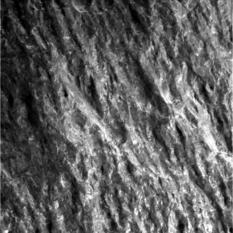
Jean Baptiste Charbonneau
Opportunity took this close-up image of Jean Baptiste Charbonneau with her Microscopic Imager (MI) in mid-February 2015. "This is an outlier, something different, a new rock type, " said MER Principal Investigator Steve Squyres, of Cornell University. The rock, which is exceptionally high in aluminum is named for Sacagawea's son and the youngest member of the Lewis and Clark Expedition.NASA / JPL-Caltech
During the past month, Opportunity put 100 meters of rusty red Martian landscape in her rear view mirror. Granted, that's not much. This rover has driven that distance in one sol. But in fairness to the aging veteran, technical difficulties to no fault of her own led to the loss of three sols or Martian days, plus she had to stand down for a day or so to get her new flight software and she stopped to check out a soil target and the rock that is proving to be so worth the time. "This is an outlier, something new, and different," said Squyres.
Around the same time on Earth, the MER engineering tiger team that has been working for three months on the planned "fix" to Opportunity's flash memory got the final approval to send up an updated flight software load, labeled R9.4. That software will prepare the team to reformat the non-volatile memory drive in coming weeks and mask off a corrupted sector or bank.
The rover uses its non-volatile flash for storing data overnight or longer for transmission later. But when unwanted reboots and “amnesia” events associated with the corrupted sector in that memory system increased in December, the MER team took it drive out of commission and commanded the rover in RAM mode, meaning the rover stores its data in RAM.
Since RAM is volatile memory, that means all data gathered during each Martian day must be transmitted to Mars Odyssey or the Mars Reconnaissance Orbiter (for downlinking to Earth) the same sol, before the rover's overnight, energy-conserving "sleep;" otherwise, it's gone when she wakes up.
Obviously, having long-term flash memory for science and engineering data is a good thing to have onboard and by February 18th, the engineers were ready to "fly" the updated flight software. Once the rover got the bundle of commands, things moved fast.
On February 24th, R9.4 was loaded and built onboard the rover. The engineers confirmed that the following day. Then on the morning of February 26th, Bekah Sosland, the MER flight director and the flash tiger team lead at the Jet Propulsion Laboratory (JPL), got the downlink she was waiting for. Just as planned and tested, Opportunity had booted up and was running her new, updated flight software.
"It went as perfectly as we could have possibly been expected," Sosland said afterward.
Opportunity is now “soaking" on this new flight software, said Bill Nelson, chief of MER engineering at JPL, home to all NASA’s Mars rovers. “We have high confidence, because we really only changed one thing and we have tested it pretty thoroughly. We just want to make sure the new flight software is running as it should and there are no unforeseen issues with it before we reformat flash.”
Nevertheless, with the updated R9.4 software, the rover returned to regular operations. “We'll still be in RAM mode for a while, but we want the team to do all the normal activities with the rover, like driving, using the IDD, just to make sure everything is fine,” said John Callas, MER project manager at JPL. “Once we're comfortable, then we'll do the reformat.”
At the end of February, the team set March 18, 2015 as reformat day. If everything goes as planned and rigorously tested, the flash will be reformatted, the corrupted bank will be masked off from use, and Opportunity's long-term memory will be restored. The robot will lose 32 megabytes of storage space in the process, but she will still have 192 megabytes to use.
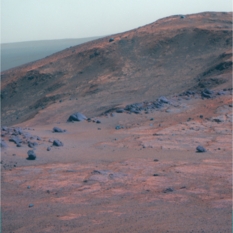
Almost there
Opportunity put 106.51 (349.44 feet) meters in the rear view mirror in February 2015 and edged closer to Marathon Valley, the upper wall of which is visible in this Panoramic Camera (Pancam) image. "We're all anxious to get there," said MER Deputy Principal Investigator Ray Arvidson, of Washington University St. Louis. But the rover also found a brand new rock this month and that may delay her entry. This image was processed by the Pancam team and is part of what will be a larger view. Its false color allows the scientists to better distinguish the various geologic formations.NASA / JPL-Caltech / Cornell / ASU
"We have shown conclusively that if we need to operate this vehicle without flash and continue to do science without Flash, we can," said Squyres. "We have done terrific things. We discovered this new rock without flash and took that amazing panorama at Cape Tribulation. So we can do it. But this software update, when it is complete – and we're not done yet – should, we hope, restore our flash file system to fully usable form and get us back to collecting data as we have for most of the past 11 years. This is a big deal for us and it's been a very rewarding thing to watch the engineering team rise to this challenge."
Meanwhile, the MER scientists were digging into the downlinked data from the new mystery rock, dubbed Jean Baptiste Charbonneau, after Sacagawea's son, the youngest member of the Corps of Discovery, more popularly known as the Lewis & Clark Expedition. "It's a rock unlike any we've seen before," said Arvidson. "It's a composition that's different than its surroundings and we're still puzzling as to what that means."
"This is a chemistry we have never seen before – ever – with either rover. It's really high in aluminum and lower in magnesium and iron than stuff we have seen in this area," elaborated Squyres. "There are some similarities to some other things we have seen, but it is not a match to anything we've seen. This is a new rock type."
While they're still working on the analyses, Jean Baptiste Charbonneau is looking to be either an igneous rock or impact melt that has undergone very little alteration. "Impact melt or igneous rock represents two lines of thought," said Arvidson. "In either case, the rock is of interest because the composition is different than what we have seen before and represents a new rock type. Perhaps from a magma that was more evolved than basalt, perhaps because the impact melt process led to a more evolved composition." Beyond that, he added: "This rock is telling us that Mars is a more complicated planet. The more we look, the more complicated and interesting the Red Planet becomes."
As February came to a close, Opportunity was still roving the crater rim, about 150 meters from her marathon finish line, and about 100 meters from Spirit of St. Louis Crater, which lies at the entrance to Marathon Valley. "We can see part way into Marathon Valley, but not the portion of the floor where we think the clay minerals are exposed. We're all anxious," said Arvidson. "But what's interesting where we are is we're seeing all sorts of fractures and uplifted portions of what we think are ancient pieces of the Martian crust."
Therein lies a rub. Opportunity is in an area of such interesting rocks that this location took one of the spotlights at the annual MER team meeting, an event that proved to be, team members report, quite a lively couple of days. "The thing that was so wonderful about the meeting was the energy level," said Squyres. "To be 11 years into this and see the team still arguing so vigorously about so many different things – from interpretation of data we collected at Gusev Crater six, seven years ago to stuff that came down in the last couple of weeks. It was great."
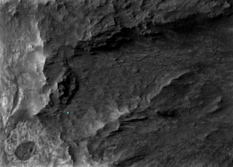
Overhead of Opportunity's location
This image, taken by the HiRISE camera onboard the Mars Reconnaissance Orbiter (MRO), shows Spirit of St. Louis Crater (lower left), which is right at the entrance to Marathon Valley. Clay minerals were discovered in the valley in 2009 with another instrument on MRO, the CRISM (Compact Reconnaissance Imaging Spectrometer for Mars). Author, MER poet, planetary outreach teacher, member of UMSF.com, and blogger Stuart Atkinson put a little dot to represent Opportunity in her approximate location at the end of February 2015. Click to enlarge. For more of Atkinson's work, check out his: The Road to Endeavour.NASA / JPL-Caltech / UA / S. Atkinson
The plan at month's end is for Opportunity to examine one more of these wildly distinct rocks with her IDD instruments and then, sometime in the first days of March, the MER science team will make a decision about what to do next. This is, after all, still a science-driven mission. "Once we have gotten an initial chemistry reading on that rock, then we will decide," said Squyres. "Beyond that because it depends on what we see. We may make two quick measurements and drive away or we may decide to hunker down and use the RAT and spend some time there."
Then again, Spirit of St. Louis Crater is just ahead and so are the various kinds of smectite clay minerals and so much more in Marathon Valley. "Impacts are Nature's drills and they allow us to explore and reconstruct the ancient crust, stratigraphy and structure," said Arvidson. That kind reconstruction will allow the scientists to fill out and add to the story of water on Mars and what this particular area of the planet was like 3 to 4 billion years ago, when the Red Planet was more like Earth.
Since Mars whipped up a small gust or two mid-month that cleared some of the recently accumulated dust from the rover's solar arrays, Opportunity is producing a robust amount of energy and ready for any assignment. With a nice little bump in power, a bounty of mystery rocks before her, a weird crater and a clayground of riches within reach, and on track to set a new, historic distance record, no one on the team seemed concerned about the MER mission being zeroed out in the NASA 2016 budget, which was prepared by the Office of Management and Budget (OMB).
Beyond being an important testament to American engineering, this robot is still sending home remarkable discoveries and achievements. “Opportunity is doing out-of-this-world-class science and we’re about to trip over a marathon!” as Callas summed it up.
Indeed. Textbook changing science about the planet in our solar system that we hope sometime in the distant future to colonize is right there for Opportunity's taking, the Earth's taking. And then there's the dedication of a tight-knit team that has evolved planetary surface exploration, a model still in motion that is providing an incredible training ground for future missions. It is almost inconceivable that thinking human beings could pull the plug on this legendary explorer, this history-making mission.
American politics, however, is a more bizarre landscape than Mars. But if pulling the plug on this diehard rover is seriously suggested as the 2016 NASA Budget is debated, the emotion from around the world that envelopes this veteran would no doubt rise up in protest. For now, Opportunity is roving on as she always has, undaunted and showing her MER mettle, seemingly determined to rove on for as long as she has it in her or until Mars takes her out.
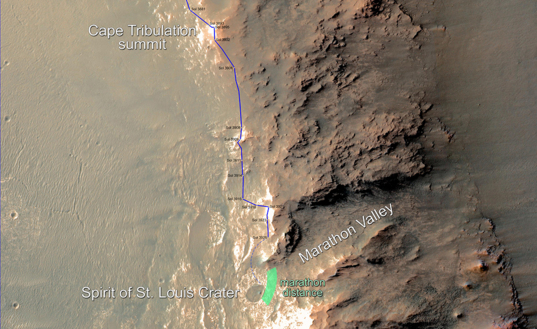
NASA / JPL-Caltech / University of Arizona
Marathon finish line
Opportunity is approaching a cumulative driving distance on Mars equal to the length of an Olympic marathon race. The map shows the rover's location as of Feb. 10, 2015, in the context of where it has been since late December 2014 and the Marathon Valley science destination ahead. "We are approximately 150 meters away from exceeding a marathon's distance," said MER Project Manager John Callas, of JPL, as February came to a close. The rover's route might zigzag as the team chooses a path into the valley, so there is uncertainty about where exactly it will pass 42.195 kilometers (26.219 miles). The green band indicates where the rover might cross the finish line.Opportunity drove out of January on Sol 3918 (January 31, 2015) and spent the first week of February driving, taking lots of images, and conducting some in-depth science.
With 41.95 kilometers (about 26.06 miles) on her odometer, the robot field geologist began the month with plenty of energy, producing a comfortable 484 watt-hours, with a solar array dust factor of 0.632. The summer sky overhead was typically hazy and the rover was reporting an atmospheric opacity or Tau of 0.949.
On Sol 3921 (February 3, 2015), Opportunity drove, following the ops strategy that's been in place since December 2014 when flash was taken out of use. She took pre-drive images, then logged 20.69 meters (67.88 feet), and then snapped post-drive Panoramic Camera (Pancam) and Navigation Camera (Navcam) images in the forward direction, all of which she transmitted that evening for data return to Earth. The next sol, the robot completed a 360-degree Navcam panorama with imagery focused in the rearward direction.
Opportunity put another 21.7 meters (72 feet) behind her on Sol 3923 (February 5, 2015), and took the routine post-drive Pancam and Navcam drive-direction images. The following sol, she took more images and completed a Navcam 360-degree panorama.
The robot field geologist wrapped the first week of the month on Sol 3925 (February 7, 2015), with the first sol of a two-sol touch 'n go, using her Instrument Deployment Device (IDD) or robotic arm to collect Microscopic Imager (MI) frames of a soil target dubbed Liver Eating Johnson, named after the colorful American Mountain Man of the Old West. Then she placed the Alpha Particle X-ray Spectrometer (APXS) on Liver Eating Johnson for a multi-hour integration, for the 'touch.'
The next sol, Opportunity drove more than 31 meters (about 102 feet) for the 'go,' finishing her day by taking more drive-direction images, and establishing another milestone, when she passed 42 kilometers (about 26.1 miles). That put the rover within about 195 meters (about 640 feet) of completing the first-ever marathon on another planet beyond Earth. [An Olympic marathon is 42.195 kilometers or 26.219 miles.]
"When Opportunity was in its prime mission 11 years ago, no one imagined this vehicle surviving a Martian winter, let alone completing a marathon on Mars," noted Callas. "Now, that achievement is within reach as Opportunity approaches a strategic science destination. What's most important about the longevity and driving distance the mission keeps extending are not numerical thresholds, but the wealth of scientific information returned about Mars, made possible by these feats."
Opportunity spent the next three sols 3927, 3928, and 3929 (February 9, 10, and 11, 2015), adding to that wealth of data, snapping images of chosen targets with her Pancam, as well as tending to the usual chores and routine tasks, like checking the atmospheric opacity or Tau.
On Sol 3930 (February 12, 2015), the rover drove about 20 meters (66 feet) to get a view into Marathon Valley, took a post-drive Navcam panorama, and then spent the next sol taking more images of selected targets. It was during those imaging sessions that the MER scientists homed in on an intriguing rock among a set of rocks exposed along the rim, just north of Marathon Valley's entryway.
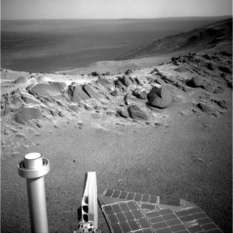
Moving in on Charbonneau
Opportunity took this image with her NavCam as she approached the rock target the team named Jean Baptiste Charbonneau on Feb. 12, 2015. It's a rock unlike any the MER scientists have seen before and although they are still analyzing the data, they think it may be an igneous rock or perhaps impact melt.NASA / JPL-Caltech
The rover that loves to rove got her Valentine wish and drove again on Sol 3932 (February 14, 2015), although it was a short jaunt of 2.95 meters (9.68 feet) to get close to that intriguing rock for an in-depth investigation. But the robot also had other assignments to complete. Before shutting down for that sol, she took an atmospheric argon measurement with her APXS for the mission-long study on the Martian atmosphere, and then spent the first two sols of the third week of February, 3933 and 3934 (February 15-16, 2015), taking a 360-degree Navcam panorama, as well as Pancam images of selected targets, including, of course, the intriguing rock.
As Opportunity was working those assignments, Mars smiled down. A small dust-guster or two cleared some of the fresh Martian powder from her solar arrays and boosted energy production by about 12 percent, above 550 watt-hours, which is more than half of the rover's full power production capability.
Finally, on Sol 3935 (February 17, 2015), the robot moved in on the unusual rock to take the close-up pictures needed for a Microscopic Imager (MI) mosaic. Then, she placed her APXS on the same spot on the rock for a multi-hour integration.
The team decided to start naming targets in this area after members of the Corps of Discovery, more popularly known as the Lewis and Clark Expedition, "except for the ones who kind of got drunk and beaten and stuff like that," chuckled Arvidson. And so they christened the rock Jean Baptiste Charbonneau.
Born in Ft. Mandan in 1805, Charbonneau, when just a toddler, accompanied his mother, Sacagewea, on the Lewis and Clark trek, and thus was the youngest member of the expedition. Mother and son are depicted from this time period on U.S. currency, the golden one-dollar Sacagewea coin.
With that science assignment finished, Opportunity drove again on Sol 3936 (February 18, 2015), for 9.8-meters (32.15 feet) to get a better view into the interior of Marathon Valley. The following sol, she documented her surroundings in images, just like a human field geologist would.
Meanwhile, on Earth, Sosland and the flash tiger team earned final approval on February 11th to send the R9.4 software load to the rover. They cleared the last "lien," a software Quality Assurance report, on February 18th and promptly sent the flight software load to the Deep Space Network (DSN) for transmission to Opportunity.
But then two cyclones hit Australia and thunderstorms closed the DSN complex in Canberra, raining on the MER team's software parade. "And that shot to the wazoo a very carefully laid out plan of science and engineering," said Arvidson.
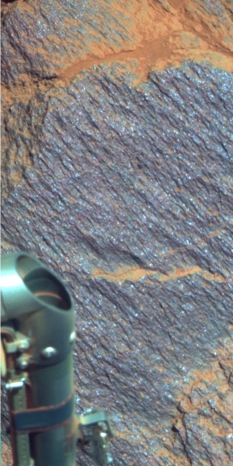
Studying Charbonneau
Opportunity spent much of the second week of February 2015 conducting an in-depth study of the intriguing rock called Jean Baptiste Charbonneau. The robot field geologist took this image with her Pancam on Valentine's Day. It was processed in false color by the Pancam team.NASA / JPL-Caltech / Cornell / ASU
So, the rover didn't get her new flight software load and the MER team essentially lost a full weekend, Sols 3938, 39, 40 (February 20, 21, and 22, 2015), as a result. The team soldiered onward. Monday, February 23rd, would be another day.
Opportunity took a few images, but basically stood down while the MER engineers at JPL real-time commanded the lifting of write protections so they could load the rover's flight software. Write protection, of course, is a safety feature that usually involves a single bit in the program that blocks any mistaken or unwanted attempts to write to the programmable read-only memory or PROM, in this case, the PROM where the rover's operating system is located.
On February 24th, at 1:22 am PST Sosland and her team sent up a bundle that contained all of the sequenced commands to build the revised flight software R9.4, which, essentially, is a patch. The commands then initiated, built, and saved the flight software into the rover's PROM 2 aka PROM B. "Then, the flight software was loaded into the working RAM memory on the CPU [central processing unit] board, which then executed it,” said Nelson. “This is also how your home computer works. You've got your operating system and everything else on your disc and it's loaded into RAM and executes out of RAM.”
The rover’s CPU then built and saved R9.4 back into the permanent non-volatile flight software area. Opportunity, however, was still operating off RAM, so it was still using the older R9.3 flight software.
The robot transmitted her event records (EVRs) showing that R9.4 made it safely onboard to Mars Odyssey for downlinking to Earth during that sol's UHF pass. Then she took a power nap. When she woke up briefly on her Sol 3943 (February 25, 2015), basically to prepare for a DeepSleep, Opportunity was ostensibly operating with her new R9.4 flight software for the first time.
“But we didn’t see that or get any EVRs, because it was a short wake-up and she then quickly went into a DeepSleep," said Nelson. Although the robot saved those event records to RAM, since there was no downlink, they "went 'poof' out of the RAM,” he said. “We had contingencies in place that would allow us to fall back to R9.3 if anything went wrong. We did not expect to deploy those contingencies, but we need to be prepared and we are.”
When Opportunity woke up from DeepSleep and sent her engineering data home, it was February 26th on Earth and Sosland and her team were waiting at The Lab. At 10:41 am PST, the rover's missive arrived.
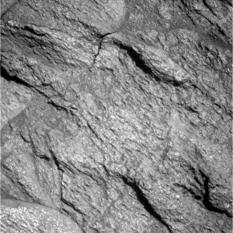
Jean Baptiste Charbonneau
As the MER scientists began digging into the data Opportunity collected at Jean Baptiste Charbonneau, they got really excited. "This is a chemistry we have never seen before – ever – with either rover," said MER Principal Investigator Steve Squyres. The robot field geologist took this picture with her Pancam on Feb.15, 2015, her Sol 3933.NASA / JPL-Caltech / Cornell / ASU
Squyres invited Sosland, who was in 8th grade when Spirit and Opportunity landed in 2004, to make the announcement at the annual MER meeting. "The build was successful and all data coming down is nominal," she recounted for the MER Update. "Opportunity is on the new flight software and working beautifully. This is the first major accomplishment toward getting the rover back on the flash file system. The reformat is next!"
"It's not only a dream come true to be working on Opportunity, but as a 25-year-old engineer, to be chosen to be the activity lead on this, and also have all the mentorship and all the people in the room rooting for me and the rest of the tiger team to get this right and successful – it's an absolute honor," Sosland reflected later. "There were a lot of people involved in this."
In addition to Sosland, the R9.4 team included veterans Rob Steele, Tam Nguyen, and Kouji Nishimoto and a host of millennials, including Mike Seibert, Heather Justice, Hallie Gengl, Eric Ferguson, and Ben Mellman, each of who burned the midnight oil for months, through the December holidays and into the New Year, testing, validating, and analyzing the revised flight software. During that time, the other MER tactical team members filled in when needed. And that's not everyone. A stellar cast of engineers served to mentor this team, including Glenn Reeves and Tracy Neilson, who saved the day back in January 2004 when Spirit "lost" it and went into a continuous reboot loop, and Todd Litwin, Jim Donaldson, Khaled Ali, Mark Maimone, and two MER officials quite familiar to MER Update readers, John Callas and Bill Nelson. All of which underscores the reality that no one roves Mars alone.
"It's just so rewarding to see this project become such a valuable training ground for young scientists and engineers," Squyres said after the meeting. "My first planetary project, when I was 22, was Voyager. I got to work with the imaging team for the fly-bys of Jupiter. It was a formative experience in my career, one that was just sort of handed to me by people who had worked so hard to make Voyager a reality. I was immensely appreciative and there was no way to pay back the Voyager team for that," he recalled. "Now, to be able to provide an Opportunity for other young people, and to see them get a chance to benefit from this – honestly, it's one of the most rewarding aspects of the entire MER project for me."
While Opportunity “soaked” the new R9.4 software, she roved on, and on Earth, "we wait,” said Callas. “We'd like a little time on the new flight software, just to make sure everything is okay. Then we'll do the reformat, which at that point should then mask off Bank 7 of the flash."

Sacagawea dollar
Known as the golden dollar, the Sacagawea coin is part of U.S. currency and has been minted every year since it was introduced in 2000. It shows the Native American explorer with Jean Baptiste Charbonneau, her son and the youngest member of the Corps of Discovery, more popularly known as the Lewis and Clark Expedition. The profile on the coin was designed by Glenna Goodacre.U.S. Mint
In the meantime, "Jean Baptiste Charbonneau is turning out to be a real doozy," said Squyres. "This does not a match to anything we've seen."
Both Squyres and Arvidson agree that Jean Baptiste Charbonneau is neither a Matijevic Formation rock like they found at Cape York or Shoemaker Formation, which makes up the terrain the rover traveled across to get to Endeavour Crater. And that it's a new rock type.
Where it stands time-wise between those two, the scientists have yet to determine. "It looks more like of pieces of probably some combination of lava flows and just churned up broken up pieces of the crust churned up by the impact, but what it is and where it fits into the picture is what we're trying to get at," said Arvidson.
"Does this rock pre-date the Endeavour event like Matijevic Formation rocks do? Is it contemporaneous with the Endeavour event like the Shoemaker Formation is? Or does it somehow post-date the Endeavour event? That's one of the challenges, one of the questions we currently face," Squyres elaborated. "We don't have enough information right now. We need to do some geologic mapping to answer that question."
As Opportunity was directed to rove toward another intriguing rock, kind of like Jean Baptiste Charbonneau in appearance but different in color, the team decided to push the schedule for reformatting flash to March 18th. "It's so the scientists can perform IDD work on those rocks where we are now, because after we do the reformat, we're asking the scientists hold off on moving the IDD for a week, to give a soak period for the flash," said Sosland. "Like the flight software, we want to make sure Opportunity is operating nominally on the newly reformatted flash file system before the rover moves the IDD."
The reason is that should the rover experience an anomaly or warm reboot during a time when she's moving the IDD, they could lose calibration of the instrument, Sosland said. No one is anticipating that, but as innovative and daring as the MER team members are – this team redefined the concept of workarounds after all – they are also cautious, keenly aware that every day on Mars is gift. “If it all works and flash is well behaved, and we've fixed the problem, then everything should go back to normal,” Callas said.
So far so good.
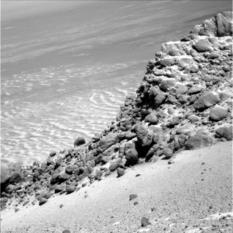
Rock on Opportunity
This, one of the last Pancam images Opportunity sent home in February 2015, shows the raw beauty and wonder of Mars. It was taken during a session of remote sensing in the final days of the month, as the robot was "soaking" its new flight software. Eventually, this image will become part of a larger view.NASA / JPL-Caltech / Cornell / ASU
As March began to peek over the horizon, only one real looming concern remained, the same concern that’s been looming for more than a decade. “It's the ever-present worry that we have a senior rover and something like a soldered joint could break any moment and it could be game over,” said Callas. “I don't know when that's going to happen I just know with each passing day, we're one day closer to that … it's true for all of us.”
But more than 550 watt-hours of power, a Tau of .734, and an improved dust factor of .674, the future still looks as bright as ever for Opportunity. As the rover works in the mix of rocks, fractures, and uplifted portions of what are probably ancient pieces of the Martian crust, the robot field geologist continues to send home "out-of-this-world-class science," as Callas described it, and is keeping the entire team enthusiastically enthused.
In fact, MER team members are over the Martian moons with what they're seeing and what lies ahead at Spirit of St. Louis Crater and especially Marathon Valley. "It's really exciting," said Arvidson, who as the team's resident stoic Swede really is excited. "What's probably happened in the past is the impact that made Endeavour Crater generated a lot of fractures and a lot of uplift of rocks of different amounts at different parts of the rim, and so we're seeing different sections of the ancient crust. And as we look north from where we are now, we're seeing different kinds of rocks, a real diversity of rocks."
That's no surprise. Actually, the MER scientists expected that. "If you remember what it was like at Gusev, Spirit was exploring material that was probably largely very ancient crater ejecta deposits," said Squyres. "Granted, it might have been ejecta from multiple craters, but there was a bewildering diversity of geochemistry at the Spirit site. More than a dozen completely unique rock types. So it's hardly surprising when we get into crater ejecta on the rim of a very ancient crater on the other side of the planet that we see some significant diversity there."
Just as for Spirit at Gusev, the diversity Opportunity is seeing brings challenges. "But this is exactly what we expect from Mars," said Squyres. "Mars has been doing this to us for 11 years. Why would it stop now? I'm not really surprised to find a totally new rock type here, and I won't be surprised when we find the next one or the one after that or the one after that."
After traveling for some six years to get to this place, Opportunity is now at long last entering a destination once only dreamed about, and Squyres is quick to note that Jean Baptiste Charbonneau is an "exciting," if not surprising discovery. "It's interesting that this has popped up right on the rim of Marathon Valley," he mused. "That may be telling us something, but what it is I don't know at this point."
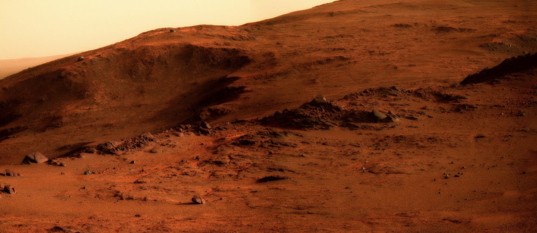
NASA / JPL-Caltech / Cornell / ASU / S. Atkinson
Marathon Valley beckoning
Marathon Valley was once but a dream destination for Opportunity and the MER team. As February 2015 faded to history, the robot field geologist was getting a better glimpse inside. "We can see part way into Marathon Valley, but not the portion of the floor where CRISM says there are clay minerals," said MER Deputy Principal Investigator Ray Arvidson. Stuart Atkinson processed this Pancam image in his Martian 'technicolor' style. For more of Atkinson's work, check out his: The Road to Endeavour.As the MER scientists begin to meet the rocky challenges, they will glean deeper insight as to what Mars was really like billions of years ago, back when it was more like Earth, and perhaps even finds clues as to what happened to all the water. For now the mission rolls on into a fresh new wonderland with her "E ticket" to the Martian past.
After putting 106.51 meters (349.44 feet) of rusty red crater rim real estate in the rear view mirror in February, Opportunity is closing in on Spirit of Saint Louis Crater, the entrance to Marathon Valley. She has 105-115 drive meters (about 344-377 feet) to go. And the valley just beyond, where she will soon finish her historical marathon, beckons with the promise of being of the most significant sites that the MER mission – or any Mars surface mission for that matter – has ever visited. There, the robot hero explorer is destined to make more history from the history she will uncover in coming months.
Despite being on the Martian road for more than 11 years, the MER team – scientists and engineers alike – veterans and newbies alike – and, of course, the rover – are fully engaged and as enthusiastic as ever. So are former team members, some who helped build this little Martian super sport, who can't help coming back now and again to mentor younger MERsters or just hang out. You can hear the excitement in their voices and see it in their faces. And there is a genuine gratitude that is so rare these days, one that is always expressed and one that has everything to do with how MER became the legend that it is.
"If you can't have fun driving rovers on Mars," said Squyres, "give it up."
Let’s Go Beyond The Horizon
Every success in space exploration is the result of the community of space enthusiasts, like you, who believe it is important. You can help usher in the next great era of space exploration with your gift today.
Donate Today

 Explore Worlds
Explore Worlds Find Life
Find Life Defend Earth
Defend Earth


